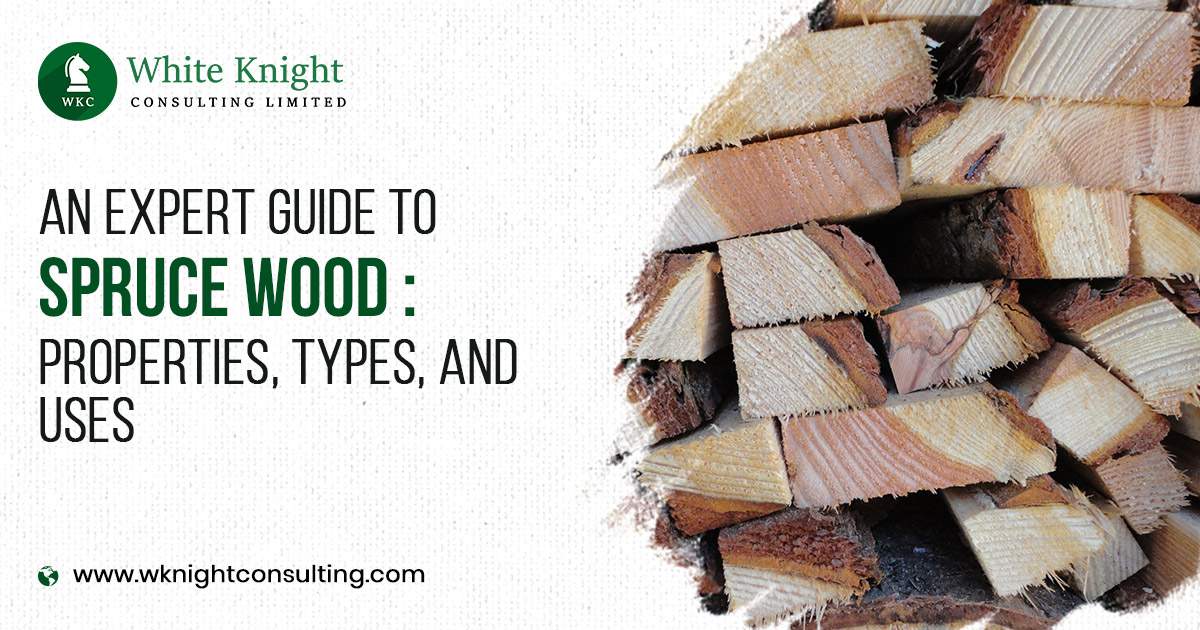Spruce is a softwood that is prized for its stability, affordability and low density, which makes it ideal for many uses, including construction timber.
Spruce is often compared with pine in terms of hardness, durability and appearance. Here’s everything you need to know about spruce wood properties, types and uses.
About Spruce Wood
Spruce is a softwood species of the Pinaceae family of coniferous evergreen trees. Spruce trees are about 115-180 ft (35-55 m) tall with a 3-5 ft (1-1.5 m) trunk diameter. Some species such as Sitka spruce can grow up to 250-300 ft.
Spruce is a fast-growing tree with an average growth rate of 8 inches to 12 inches per year.
Spruce wood species can be found in many regions around the world, both in natural forests and plantations. The most popular Norway Spruce is native to Northern and Central Europe but is also grown on plantations in many regions of the United States. The plantation timber is, however, not always as good as native wood.
The most popular species or types of spruce wood include white spruce, Sitka spruce, Norway spruce, black spruce, and red spruce.
Spruce Wood Properties
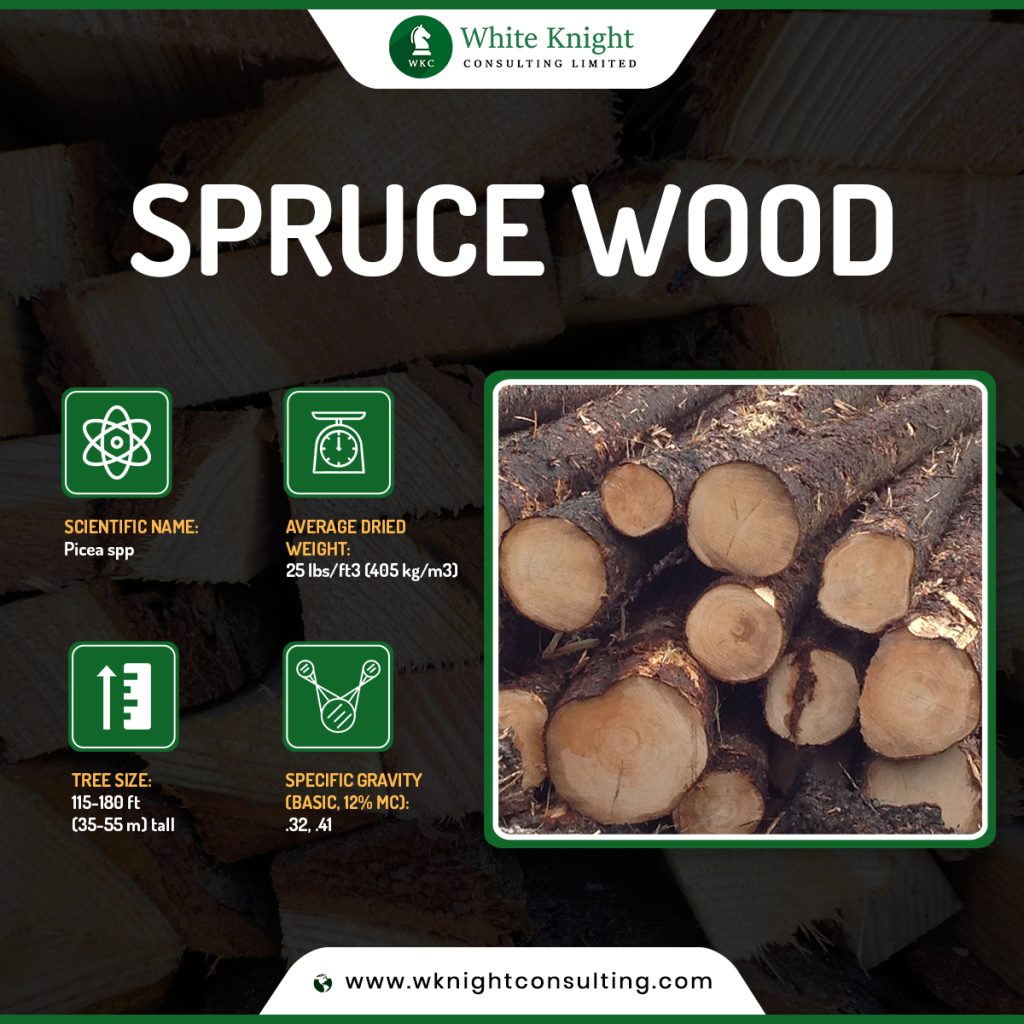
Spruce appearance – what does spruce wood look like?
The colour of spruce may range from reddish-brown to yellowish or creamy-white depending on the species. Norway spruce heartwood is generally a creamy white with a yellowish or reddish hue. Spruce has a straight grain and a fine and even texture, which makes it easy to cut with machines and hand tools. There are often knots present across the heartwood.
Density & Weight: Spruce is a lightweight material with low density and hardness. The Janka hardness rating of Spruce ranges between 380 lbf – 52 lbf, which makes it a low-density wood. The average dried weight is around 405 kg/m3, which is low as per industry standards.
Strength: Carefully dried spruce is remarkably strong and doesn’t shrink much. It bends easily and can be used for building strong boats.
Workability: The low weight, stability and low density of spruce make it easy to handle and convenient to work with. It is also easy to work with tools. The presence of knots in spruce can sometimes cause problems when cutting. It is easy to glue and finish. Staining, however, may require the use of a sanding sealer or gel stain to avoid blotching due to the close pore structure of spruce wood.
Durability: Spruce is moderately durable in terms of resistance to rot and decay. As a low-density softwood, spruce is prone to dents and scratches and is not suitable for use in high-traffic flooring or outdoor use.
Allergic reactions: Reported as a sensitizer, Norway Spruce has been found to cause skin irritation and respiratory problems like asthma in some people.
Availability & price – how much does spruce timber cost?
Spruce is generally easily and widely available and is more inexpensive than most hardwoods and softwoods. It is grown in many regions around the world. Construction-grade spruce, which is the most popular use of spruce wood, is affordable and easy to find.
However, instrument-grade spruce, especially Quartersawn billets of Norway Spruce, are among the most expensive woods in the world. This is often sold under fancy names such as German Spruce, Yugoslavian Spruce, etc.
Technical specifications of Spruce:
- Average Dried Weight: 25 lbs/ft3 (405 kg/m3)
- Specific Gravity (Basic, 12% MC): .32, .41
- Janka Hardness: 380 lbf (1,680 N)
- Modulus of Rupture: 9,130 lbf/in2 (63.0 MPa)
- Elastic Modulus: 1,406,000 lbf/in2 (9.70 GPa)
- Crushing Strength: 5,150 lbf/in2 (35.5 MPa)
- Shrinkage: Radial: 3.9%, Tangential: 8.2%, Volumetric: 12.9%, T/R Ratio: 2.1
Types of Spruce Wood
There are about 40 species of spruce (genus Picea), of which the most popular types are white spruce, Sitka spruce, Norway spruce, black spruce, and red spruce.
1. White Spruce
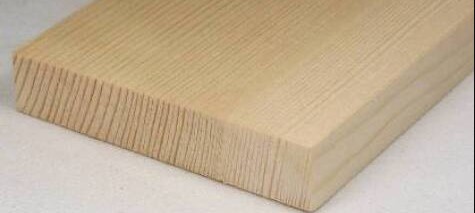
White spruce is native to Northern North America. The trees are about 34 m tall and have a .6-1.0 m trunk diameter. The heartwood of white spruce is yellowish-white, sometimes with black knots. The texture is uniform and the grain is straight and fine.
White spruce is low to moderately durable in terms of rot resistance. It is used for paper pulp, crates, millwork, and construction timber.
2. Sitka Spruce
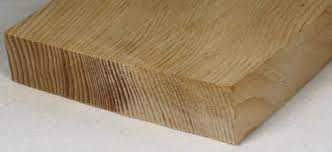
Sitka Spruce trees are found in Northwestern North America and are about 40-50 m tall with a 1.2-1.8 average trunk diameter. The heartwood is creamy white or yellowish or reddish and sometimes has a bearclaw grain pattern. The grain is straight and the texture is fine and uniform. The wood is not very durable in terms of decay resistance.
Uses of Sitka spruce include paper, crates, boxes, construction, musical instruments, masts, furniture, and wind turbine blades.
3. Norway Spruce
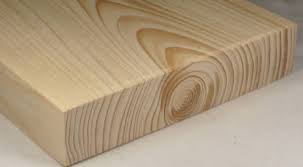
Norway spruce trees are native to northern and Central Europe and are about 35-55 m tall. The heartwood colour is creamy white, often with a red-yellowish hue. The grain is straight and the texture is fine and even. It is a non-durable wood with poor decay resistance.
Norway spruce is easy to work with and very popular in applications like musical instruments, construction, Christmas trees, millwork, paper pulp, crates, etc.
4. Black Spruce
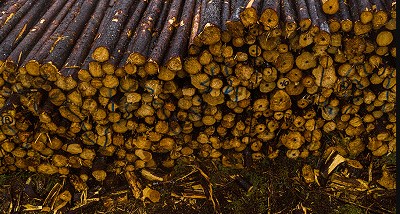
Black spruce has a yellowish-white heartwood with a straight grain and a uniform, fine texture. The trees are about 10-15 m tall. The wood is non-durable in terms of decay resistance. It is lightweight and easy to handle and work with.
Typical uses of black spruce include paper pulp, crates, construction, millwork, etc.
5. Red Spruce
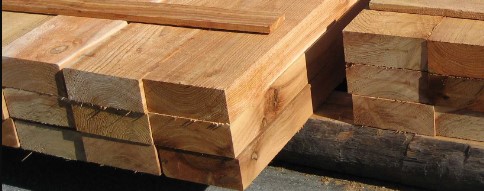
Red Spruce trees are native to Eastern North America and are about 24-34 m tall. The heartwood has an average dried weight of 435 kg/m3. It is creamy white or yellow with a hint of red. The texture is fine and even and the grain is straight. While this type of spruce wood is only moderately resistant to decay, it’s still a popular choice among woodworkers due to its versatility & accessibility.
Applications of red spruce wood include paper pulpwood, construction, Christmas trees, millwork, crates, and soundboards for musical instruments.
Uses of Spruce Wood
Spruce is a versatile lumber that is considered suitable for use in many applications.
Typical uses of spruce wood include paper (pulpwood) manufacturing, construction lumber, interior millwork, boxes and crates, Christmas trees, and soundboards for musical instruments.
Construction: Spruce is widely used as a building material for constructing doors, interior millwork and cabinets. It is also used for building boats, barrels, and parts for aeroplanes. Spruce wood is a preferred choice for construction because it is readily available at a lower price than other softwoods and hardwoods. Moreover, it is a strong wood that is easy to work with and bends easily to make special shapes and structures.
Paper industry: Spruce wood pulp is primarily used for manufacturing papers and boxes. As a softwood with long cellulose fibre, spruce is a great choice for the paper industry. As a lightweight wood, spruce is also a good choice for making high-quality boxes and crates that are strong, can hold significant weight and are easy to handle and move.
Christmas trees: Different species of spruce are used for Christmas trees because of their unique, triangle shape. Blue spruce is the most famous choice for Christmas trees.
Musical instruments: The resonant characteristic of spruce wood makes it suitable for use in musical instruments such as sounding boards for pianos and to make violins. Spruce is also commonly used for making guitar tops.
Boats & Aircraft: Spruce is also commonly used for making lightweight and strong boats and aircraft. Though the wood is not naturally durable, it can be treated to make it resistant to moisture and decay for use in boatbuilding.
Firewood: Spruce is also often used for firewood. It burns quickly and is easy to split. Also, it is easily available and inexpensive.
Pros & Cons of Spruce Wood
Spruce is a popular hardwood species that is cheap, strong and easily available.
Pros:
- Easily available
- Inexpensive
- Versatile – can be used in many applications
- Easy to work with – staining (using a pre-conditioner) and painting spruce is easy to achieve any style you want
- Can be treated to enhance durability
- Great appearance
- Medium rot resistant
Cons:
- Not very durable – not suitable for outdoor uses
- Requires more maintenance
- Prone to insect attacks
Where to Buy the Best Quality Spruce Wood?
Spruce is a suitable softwood for many applications. It is preferred by woodworkers because of its easy availability, low price and versatility.
With so many species of spruce out there, it can be difficult to choose the right one. You can call our experts at White Knight Consulting Ltd to consult to find out the best spruce type for your project.
If you are looking to buy spruce timber or raw wood, we can offer you the best price with doorstep delivery all over the world. White Knight Consulting Ltd is a top supplier and exporter of softwood timber. We have spruce available in many varieties and sizes and all our wood is sustainably sourced and produced by skilled workers. We offer a competitive price for our wood with a special wholesale discount. Contact us to know more.
